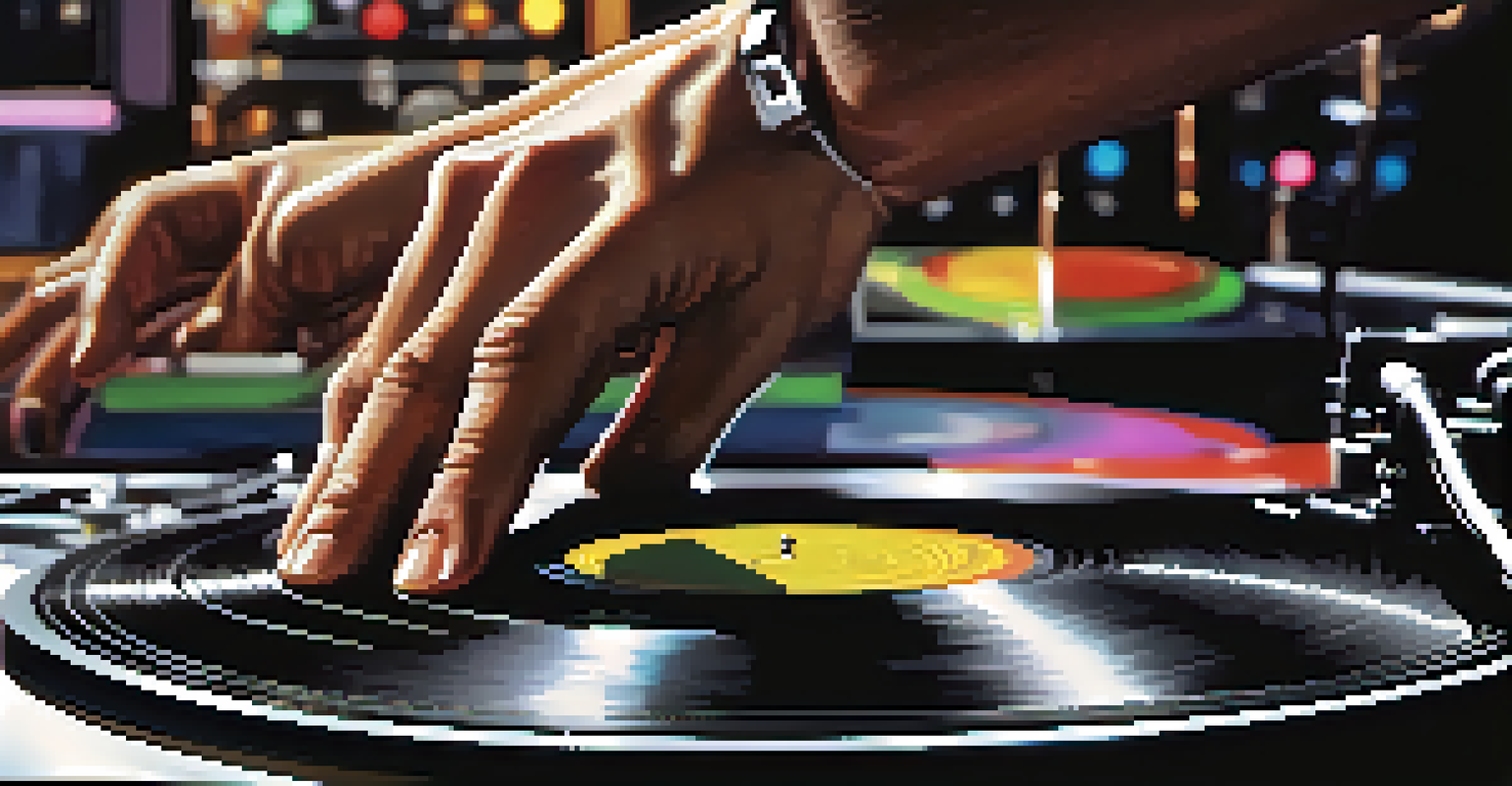The Art of Scratching: Techniques Every DJ Should Know

Understanding the Basics of Scratching for DJs
Before diving into advanced techniques, it's crucial to grasp the fundamental concept of scratching. Essentially, scratching involves moving a vinyl record back and forth under a needle to create unique sounds. This art form has its roots in hip-hop culture and has evolved into a vital part of DJing across genres.
The only way to do great work is to love what you do.
DJs often use scratching not just for rhythm but also to add flair and personality to their sets. It’s like adding a personal signature to your music, making your performance stand out. Understanding the mechanics behind scratching allows DJs to experiment and innovate.
By starting with the basics, DJs can build a strong foundation that will support more complex techniques later on. Think of it as learning to walk before you run; mastering basic scratching is essential for unleashing your creativity in the mix.
Essential Scratching Techniques to Practice
There are several key scratching techniques every DJ should learn, including the baby scratch, transformer scratch, and chirp scratch. The baby scratch is straightforward and serves as a great starting point for beginners. It involves moving the record back and forth while keeping the crossfader open and closed, producing a simple yet effective sound.

The transformer scratch, on the other hand, adds a bit more complexity. By quickly cutting the sound on and off with the crossfader while moving the record, DJs can create staccato-like effects that are dynamic and rhythmic. This technique is especially popular in hip-hop and electronic music.
Master Basic Scratching Techniques
Understanding fundamental scratching techniques lays the groundwork for creative expression and innovation in DJing.
Lastly, the chirp scratch combines elements of both the baby and transformer scratches. It involves a quick cut of the fader while moving the record, creating a sharp, chirpy sound that can be very catchy. Practicing these techniques regularly will help DJs develop their skills and find their unique style.
The Importance of Timing and Rhythm in Scratching
Timing and rhythm are at the heart of effective scratching. Just like a drummer relies on a metronome, DJs need to understand the beat to synchronize their scratches with the music. This synchronization creates a seamless flow, enhancing the overall listening experience.
Creativity is intelligence having fun.
Practicing with a metronome or along with your favorite tracks can help you develop a strong sense of timing. Start slow and gradually increase your speed as you become more comfortable with the movements. This approach not only builds muscle memory but also improves your confidence as you scratch.
Additionally, paying attention to the rhythm of the music can inspire new scratching patterns. Experimenting with different tempos and styles will keep your sets fresh and engaging, allowing you to connect with your audience on a deeper level.
Using Effects to Enhance Your Scratching Skills
Incorporating effects can elevate your scratching to the next level. Effects like reverb, delay, and filters can add depth and texture to your sound. For instance, a delay effect can create an echoing sound that complements your scratches, making them more captivating.
Many DJ mixers and software come equipped with built-in effects, allowing you to experiment in real-time during your sets. This flexibility means you can adapt your sound on the fly, tailoring your performance to the vibe of the crowd.
Timing Enhances Scratching Impact
Synchronizing scratches with the beat creates a seamless flow that captivates the audience and elevates the overall performance.
However, moderation is key. Overusing effects can muddle your sound and distract from the scratching itself. The goal is to enhance your skills, not overshadow them, so find a balance that works for you and your style.
Building Your Own Unique Scratching Style
While mastering techniques is essential, developing your unique scratching style sets you apart from other DJs. This individuality can come from blending different techniques, experimenting with effects, or even incorporating live instruments into your sets. Your style reflects your personality and musical influences.
Listening to various genres and artists can inspire you and help refine your approach. Take notes on what catches your ear and consider how you might incorporate those elements into your scratching. Remember, the best DJs are those who aren’t afraid to innovate and push boundaries.
Don't hesitate to showcase your personality during performances. Whether you're playful and energetic or smooth and laid-back, let your style shine through. Your audience will appreciate the authenticity, and it can lead to a more memorable experience for everyone.
The Role of Practice in Perfecting Your Scratching
Like any skill, perfecting your scratching technique requires consistent practice. Setting aside dedicated time each week to focus on your scratching will help you progress more quickly. Even just 15-30 minutes a day can lead to significant improvements over time.
Consider recording your practice sessions to track your progress. Listening back can provide valuable insight into areas that need improvement and help you identify your strengths. This self-evaluation can be a powerful tool for growth.
Develop Your Unique DJ Style
Blending techniques and personal flair allows DJs to showcase their individuality, making performances more memorable and engaging.
Additionally, don’t shy away from seeking feedback from fellow DJs or mentors. They can offer constructive criticism and tips that you might not have considered. Collaboration and community are integral to the DJ culture, and learning from others can enhance your skills tremendously.
How to Incorporate Scratching into Live DJ Sets
Incorporating scratching into your live sets can create a dynamic atmosphere that engages the audience. It’s about knowing when to showcase your skills and when to let the music flow. Timing your scratches to key moments in a track, like transitions or drops, can amplify the impact of your performance.
Building tension by teasing scratches before a drop can captivate the crowd, setting them up for an explosive moment. This technique creates anticipation and excitement, making your performance unforgettable.

Ultimately, the key is to remain fluid. If the energy of the crowd shifts, be ready to adapt your scratching style accordingly. Flexibility and responsiveness are vital traits for any successful DJ, ensuring that you maintain a connection with your audience throughout your set.